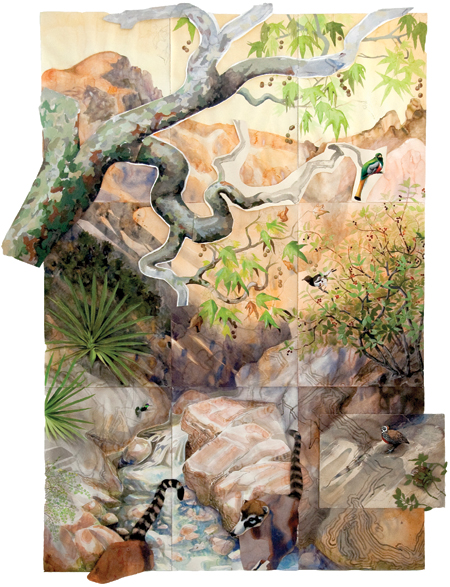
Border Troop, 2009, Graphite, ink, colored pencil, gouache and watercolor wash 132" x 96" overall, Photo courtesy Electric Works
Barnett NewmanŌĆÖs famous joke about art history being irrelevant to artists, just as ornithology is to birds, has always been irrelevant to ornithologists, even if it ruffled art historiansŌĆÖ feathers. But current events have cast further doubt on its accuracy. Not only does the proliferation of contemporary art require more analysis than ever, but the dwindling avian universe needs professional expertise, too, in warding off extinction. For too long weŌĆÖve ignored the canaries in the coal mine–even though some, admittedly, were amphibians, with extra legs.
Portraitist David Tomb may not be a dedicated wildlife artist like Audubon or Fuertes, but he is a dedicated birder who has created mixed-media paintings on paper (complemented by tropical plants, stuffed birds, and recorded birdsong) based on his pilgrimages to bird habitats in MexicoŌĆÖs Chihuahua, San Blas, Jalisco, and El Triunfo. This show examines the wildlife of northern Mexico, mostly avian, but also pedestrians like the roadrunner and Gila monster. More typical are depictions on medium-sized or large sheets of watercolor paper that place their perched, paused subjects–e.g., aplomado falcon, chachalaca, vermilion flycatcher, great kiskadee, tropical parula, and crimson-collared grosbeak–atop contorted branches and sprays of foliage before blank or blurred backgrounds. The birds are rendered accurately enough to suit any birder, but without the hyperreal detail that Audubon captured, having shot his models–or his anthropomorphic sense of drama. Instead, Tomb depicts moments of stasis–birds caught by the camera and given a larger, eternal context via artistic license, with the artifice occasionally revealed, as in Border Troop, a monumental collage of unretouched fragments, or the single-sheet Ferruginous Pygmy Owl and Green Jays, clearly a composite view. TombŌĆÖs goal in both painting and politics is clearly preservation; he combines art and environmentalism in a way that is accessible both to children, who have flocked to the show with their schoolmates, and to wary, solitary adults working their way down their ŌĆ£life listsŌĆØ of must-see art.